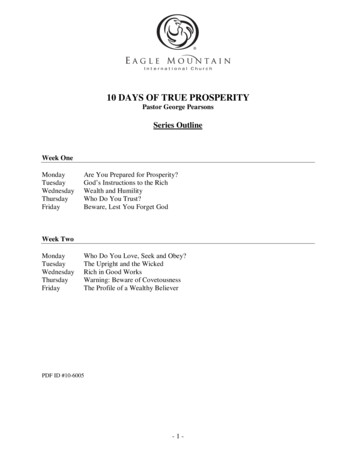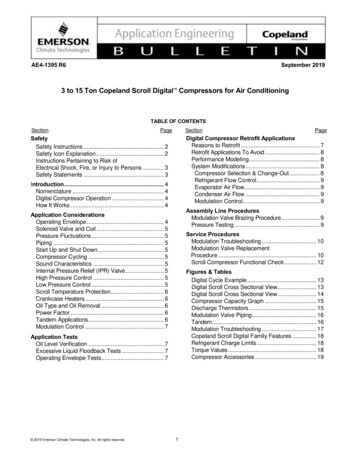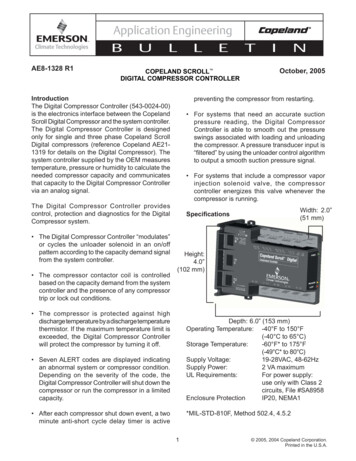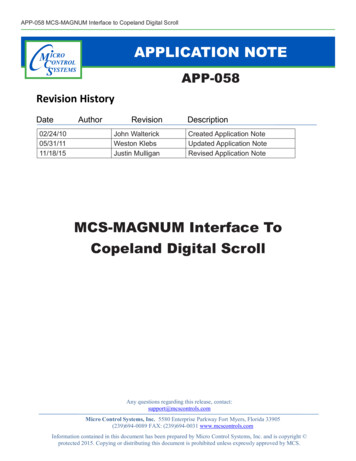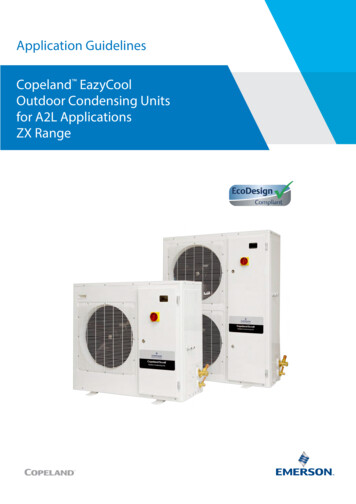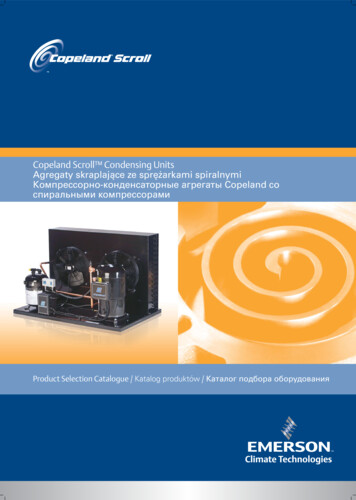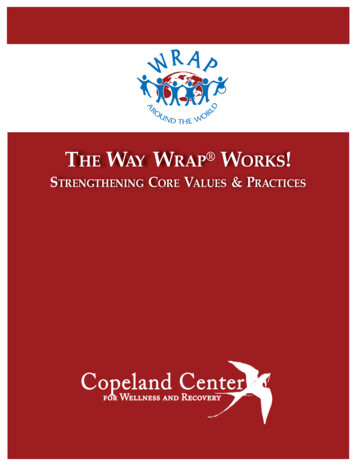
Transcription
THE WAY WRAP WORKS!STRENGTHENING CORE VALUES & PRACTICES
THE WAY WRAP WORKS!Strengthening Core Values & PracticesTable of ContentsExecutive Summary. 2Introduction. 3History of the Development of WRAP . 4About the Copeland Center forWellness and Recovery. 6What is WRAP ?. 7What’s The Problem?. 10What’s The Solution? . 12Appendix A . 18Appendix B . 19Appendix C . 20Copeland Center for Wellness & Recovery 2014The Way WRAP Works! – 1
EXECUTIVE SUMMARYThe Wellness Recovery Action Plan (WRAP ) is a personalized wellness and recovery systemborn out of and rooted in the principle of self-determination. In 2010, WRAP was recognized by theUnited States Substance Abuse and Mental Health Services Administration (SAMHSA) as an evidencebased practice and listed in the National Registry of Evidence-Based Programs and Practices(http://nrepp.samhsa.gov). Researchers from the Department of Psychiatry at the University of Illinoisat Chicago (UIC) released the results of a rigorous study that demonstrated significantly positivebehavioral health outcomes for individuals with severe and persistent mental health challenges whoparticipated in peer-led WRAP groups. Research studies on WRAP from UIC cited that positive outcomes were tied to the fidelity of the WRAP facilitation model designed by Mary Ellen Copeland anddeveloped by the Copeland Center. Today, WRAP is being widely implemented by behavioral healthsystems, however, significant compromises to the resources provided and fidelity in implementingWRAP is falling short of the quality people in recovery deserve. People in recovery deserve the bestservices we have to offer!The following paper addresses the need to strengthen our values and practices through partnershipswith behavioral health organizations and systems to adhere more closely to the fidelity standards ofthe WRAP model as designed. This paper will guide you through the following key standards: Participation in WRAP groups and services is completely voluntary Individuals are trained to use WRAP through a peer group process WRAP groups are facilitated by two properly-trained Facilitators WRAP groups are facilitated by Facilitators who complete a Copeland Center WRAP Refresher Course at least once every two years WRAP group participants and WRAP Facilitators receive appropriate mentoring WRAP groups are conducted in strict adherence to the core ethics and values of WRAP asdefined by the Copeland Center WRAP groups are utilizing the copyrighted curriculum developed by Mary Ellen CopelandThe key to ensuring that recipients of behavioral health services receive the full benefit of usingWRAP is for the leaders and participants in behavioral health organizations to better understand andincorporate the ethics, values, and practices that Mary Ellen Copeland, the Copeland Center, and thegrassroots practitioners of WRAP have established. This paper serves as a guideline for how behavioralhealth organizations can implement WRAP with fidelity to the model as designed by people in recovery with Mary Ellen Copeland and developed by the Copeland Center.After a long history of failed and even abusive treatment in mental health, today we have simple,safe, and practical resources to support people through WRAP . People in recovery deserve the verybest supports we can offer -not quick fixes and half-efforts. We hope this paper will support you tooffer and ensure the very best WRAP programs.2 – The Way WRAP Works!Copeland Center for Wellness & Recovery 2014
INTRODUCTIONThe following advocacy paper is an expressionof the persistent and insistent voices of the grassroots practitioners of the Wellness RecoveryAction Plan (WRAP ) who are working with andwithin the behavioral health system. This paperis meant to sound an alarm, to challenge the status quo, to spark a system-wide conversation,and to be a catalyst for system transformation.Self-advocacy is one the core values of WRAP ,and people using and teaching WRAP arealways encouraged to speak out if their needs arenot being addressed or when they feel that thecollective process can be improved.The practitioners of WRAP have beenspeaking out in concern about how WRAP isbeing implemented by many behavioral healthorganizations and systems.The Copeland Center for Wellness and Recovery (Copeland Center) is the hub of an organic,grassroots movement of individuals usingWRAP as a personalized system for wellnessand recovery. WRAP practitioners, facilitators,and trainers communicate to and through theCopeland Center. One of The Copeland Center’sresponsibilities is to articulate and amplify the positions of individuals using and teaching WRAP in the field. In carrying out that role, the CopelandCenter has published this paper titled The WayWRAP Works: Strengthening Core Values andPractices.In February 2013, agroup of WRAP practitioners from across theUnited States and aroundthe world gathered in Vermont for a three-day Leadership Institute Conferencewith Mary Ellen Copelandand Copeland Centerstaff members. One of thepriority discussions at theconference focused on the challenge of how tomake WRAP accessible to millions of people inneed while also maintaining its integrity. Conference attendees recognized the need to workwithin health systems, particularly the behavioralCopeland Center for Wellness & Recovery 2014health system. However, there was a group consensus that any system incorporating WRAP needed to follow guidelines that ensured fidelityto WRAP ’s core principles and practices. Thepeer participants at the conference called on theCopeland Center to develop and disseminate apaper that clearly delineates the ethics, values,and practices that health systems need to adhereto when implementing WRAP services. Sincethis mandate aligned with numerous requests theCopeland Center had been receiving from thefield for several years, the decision was made tofollow the lead of the people with most at stake –those who use WRAP to sustain their own wellness and recovery.This paper addresses the need for behavioralhealth organizations and systems to adhereclosely to the fidelity standards of the WRAP model designed by Mary Ellen Copeland and developed by the Copeland Center. To that end, thispaper presents guidelines for how behavioralhealth organizations and systems can implementWRAP with fidelity. The Copeland Center encourages stakeholders to use this paper as a toolfor initiating a dialogue between WRAP practitioners, facilitators, trainers, and behavioralhealth administrators and professionals. Progresscan only be achieved through positive communication and collaboration.The underlying premise of this paper is that theinterests of people withbehavioral health challenges will best be servedby the development of amutually respectful partnership between theCopeland Center and behavioral health organizations and systems in theUnited States and aroundthe world. The CopelandCenter welcomes the opportunity to work collaboratively with behavioralhealth organizations and systems for the benefitof people seeking to advance and maintain theirown health and wellness.The Way WRAP Works! – 3
HISTORYOF THEDEVELOPMENT OF WRAP The Wellness Recovery Action Plan (WRAP )was developed by people who had been livingwith a variety of mental health challenges andwho were working hard to feel better and get onwith their lives. In 1997, several dozen individuals who had experienced serious mentalillnesses came together in Northern Vermont foran eight-day gathering designed to initiate dialogues on how to improve their emotional andmental health. Many of the conference attendeeshad been residents of state psychiatric hospitalsat various periods in their lives. They came together to discuss practical strategies for regainingand sustaining their own wellness. They did notknow it at the time, but this cadre of intrepid explorers was blazing the trail towards a new international self-help movement for wellness andrecovery.Hope, Personal Responsibility,Education, Self-Advocacyand SupportA key leader among those brave pioneers at theVermont gathering was Mary Ellen Copeland, awoman who had been struggling with anxiety,depression, and extreme mood swings that hadcaused her to experience social isolation, economic hardship, and repeated hospitalizations.Seeking to restore her health and reclaim her life,Mary Ellen had become disillusioned with thepsychiatric establishment of that time and its reliance on medication-focused treatment that prioritized managing her illness rather thanfacilitating her return to health. She began herown journey to find strategies for recovery byconducting a survey of her peers on the subject.The survey engaged 125 respondents. Throughthe survey responses, Mary Ellen identified fivekey concepts to recovery (Hope, Personal Responsibility, Education, Self-Advocacy and Support),along with “tricks” for feeling better, which4 – The Way WRAP Works!would later be called wellness tools. She beganto facilitate peer support groups with other peoplelooking for ways to get better. By 1997, MaryEllen’s research and facilitation were generatingwidespread attention, resulting in an invitation tolead an eight-day peer support retreat in Vermontthat was destined to make history.They presented it to the group,and everyone felt excited aboutthe concept of “WRAP.”Mary Ellen helped her fellow sojourners at theVermont conference to draw on their own organicexperience to identify what kinds of strategiesworked for them to prevent emotional and mentalbreakdowns and to maintain positive mentalhealth. However, one of the participants – awoman named Jess Parker – stood up and said,“This is all well and good, but I have no idea howto organize these tools and strategies in my life.”Mary Ellen and Jane Winterling, a colleague whowas also attending the gathering, felt challengedto respond to Jess’s common sense observation.Jane and Mary Ellen worked together to developa simple system for organizing a personal “wellness recovery action plan”. They presented it tothe group and everyone felt excited about theconcept of “WRAP.” They left the gathering witha renewed spirit of hope and optimism.These values and practicesformed the basis of today’sevidence-based practiceof WRAP .Mary Ellen went home from the Vermont conference and began to use a WRAP to support herown wellness regimen. She was amazed by thepower of the WRAP to help her anticipate andcope with life’s inevitable stress and difficulty, toremain centered, and to focus on positive attitudes and activities. Being a natural teacher andCopeland Center for Wellness & Recovery 2014
communicator, Mary Ellen was inspired to shareher gift with the world. In 1997, she wrote herfirst primer book on WRAP, which rapidly gainedpopularity across the United States and aroundthe world. Mary Ellen began to share WRAP withother people who were struggling with a widerange of emotional, physical, and mental healthchallenges. She also started mentoring peers infacilitating workshops on WRAP. Next, she developed an evaluation of what constituted a successful WRAP workshop and established a list ofnon-negotiable values and practices for WRAPFacilitators. These values and practices formedthe basis of today’s evidence-based practice ofWRAP .Copeland Center for Wellness & Recovery 2014Over the past decade and a half, Mary EllenCopeland has reached millions of people throughher books and lectures, empowering men andwomen from diverse communities and all walksof life to use WRAP for their own personal recovery journeys. Now, WRAP is being utilizedin formal and informal recovery programs in all50 U.S. states and in countries around the world.WRAP is being implemented by behavioralhealth departments, mental health agencies, addictions treatment programs, as well as an arrayof other recovery groups in the United States andacross the globe.The Way WRAP Works! – 5
ABOUT THE COPELAND CENTERFOR WELLNESS AND RECOVERYIn 2003, Mary Ellen Copeland, along with otherpeople in recovery and supportive allies, foundedthe Copeland Center for Wellness and Recovery(Copeland Center) to promote mental health recovery through education, training, and researchbased on WRAP . The Copeland Center wasnamed in honor of, and dedicated to the memoryof Mary Ellen’s mother – Kathryn StrouseCopeland (1912-1994) – whose courageous struggle to face and overcome mental health challenges was a lifelong inspiration to her daughter.training required to become a certified AdvancedLevel WRAP Facilitator. The Center has trainedand supported Advanced Level WRAP Facilitators from communities across the United Statesand in Canada, Japan, New Zealand and severalother countries. Dr. Mary Ellen Copeland worksexclusively through The Copeland Center to helporganizations develop Advanced Level Facilitators who can provide local WRAP trainings thatmeet the criteria of WRAP as an evidence-basedpractice.The Copeland Center is a non-profit, 501(c)(3)organization that provides training, consultation,and program activities to support the wellnessand recovery journeys of individuals. It furtherenhances the effectiveness of recovery groups,healthcare providers, healthcare organizations,and healthcare systems that seek to support individuals’ recovery and wellness. The purpose ofthe Copeland Center’s WRAP initiative is toThe Copeland Center is the hub of an organic,grassroots movement of individuals usingWRAP as a personalized system for wellnessand recovery. In order to ensure that the international WRAP movement is healthy andstrong, the Copeland Center has created and sustained a worldwide network of WRAP students,educators, and practitioners. The role of theCopeland Center is to develop and disseminatethe ethical guidelines, model practices, and scientific research that has earned WRAP the statusas an evidence-based recovery practice whiletraining and supporting individuals to master theskills for learning, facilitating, and using WRAP .1) Disseminate the most creative, exciting, andeffective developments in the field of WRAP ;2) Teach new skills to people who are utilizingWRAP in innovative recovery programs and intheir own lives;3) Network thousands of passionate and committed WRAP facilitators, students, and practitioners from across the world to join forces andleverage their potential;4) Inspire individuals and representatives oforganizations and systems to take their knowledge and skills back to their own communitiesand make WRAP a living source of healing andtransformation at the grassroots level.The Copeland Center is the world’s preeminentorganization advancing the knowledge, skills,and values of the evidence-based recovery practice of WRAP . The Copeland Center is the onlyorganization in the world which conducts the6 – The Way WRAP Works!The Copeland Center sponsors the annualWRAP Around the World Conference, whichbrings together people from around the world –representing all ages and all walks of life – whouse, teach, and study WRAP . In January 2013,more than 450 people from Asia, Australia,Europe, and North America gathered to exchangeideas and share skills in Oakland, California.Conducted over the course of three days, the2013 WRAP Around the World Conference featured more than 70 workshops and presentationsby leaders in the field who addressed what thefuture of the recovery field holds and howWRAP will fit into the new international healthcare paradigm. The WRAP Around the WorldConference is one example of how the CopelandCenter is facilitating the growth and developmentof the worldwide WRAP movement.Copeland Center for Wellness & Recovery 2014
WHAT IS WRAP ?A BASIC PRIMER“This [WRAP ] has changed my life completely.I used to think of myself as this “mentally ill”person. Now I am a person who knows how totake care of myself and help myself in difficulttimes. If I am feeling badly or having a hard time,I take action. And there are so many simple, safethings I can do.”– a practitioner of the Wellness Recovery Action PlanIllness self-management programs for individuals with chronic medical conditions, such asarthritis, diabetes, cancer, and asthma, have beenrecognized as an important component of patientcentered medical care for many years (Instituteof Medicine, 2001). Two decades of research studies have validated the fact that significant numbers of people with mental health problems andchallenges with addictions have also been able toself-manage their conditions with positive outcomes (Onken, Craig, Ridgway, et al., 2007). Specific interventions and practices have beendeveloped to promote self-managed recovery(Bodenheimer and Lorig, et al., 2002). WRAP isprobably the most widely disseminated selfmanagement practice in the United States(Roberts & Wolfson, 2004), and its use by individuals and health systems is increasing aroundthe world (Copeland, Cook, & Razzano, 2010).WRAP is a manualizedself-management and recovery system for personscoping with diverse physical and behavioral healthchallenges. WRAP is awellness and recovery approach that helps peopleto: 1) decrease and prevent intrusive or troublingfeelings and behaviors; 2) increase personal empowerment; 3) improve quality of life; and 4)achieve their own life goals and dreams. Workingwith a WRAP can help individuals to monitoruncomfortable and distressing feelings and behaviors and, through planned responses, reduce,modify, or eliminate those feelings. A WRAP also in- cludes plans for responses from otherswhen an individual cannot make decisions,take care of him/herself, and/or keephim/herself safe. TheCopeland Center for Wellness & Recovery 2014person who experiences health challenges is theone who develops a personal WRAP . The person may choose to have supporters and/or healthcare professionals help him or her create theWRAP , but the individual remains in control ofthe process. (Copeland, Mary Ellen, PhD, Wellness Recovery Action Plan, 2011)WRAP is a wellness andrecovery approach . . .Individuals learn to use WRAP through apeer-led and peer-engaged group process thatprogresses in three distinct phases: 1) a peerdelivered introductory session in which participants learn about WRAP and become engaged;2) eight to twelve weekly (or bi-weekly) peer-ledWRAP development sessions that are approximately two hours in duration; and 3) ongoingvoluntary WRAP groups that facilitate peersupport. The single criterion for engagement inany WRAP group is that the person must bewilling to participate.Formal WRAP groups typically range in sizefrom 10 to 15 participants and are led by twotrained co-facilitators who are peers who useWRAP for their own recovery. Information isdelivered and skills are developed throughlectures, discussions, and individual and groupexercises. Key WRAP concepts and values areillustrated through examples from the lives of theco-Facilitators and participants. WRAP participants create a personalized recovery system ofwellness tools and action plans to achieve a selfdirected wellness vision despite life’s daily challenges. Participants are encouraged, and whenpossible, assisted to continue meeting after theformal 8 to12 week period has ended and to support each other in using and continuously revising their WRAP plans. A person’s WRAP is atool that can be used for a life time, and a voluntary WRAP group can be a long-term peersupport resource for ensuring that this valuableand personalized recovery system remains sharpand useful for building a healthy and successfullife in the community.The Way WRAP Works! – 7
WRAP ’s Status as an Evidencebased PracticeAn evidence-based practice is an interventionthat has been proven to be effective through randomized, controlled clinical trials, constituting arigorous research design. A randomized, controlled trial is a study design that randomlyassigns participants into an experimental groupor a control group. As the study is conducted, theonly expected difference between the control andexperimental groups is the outcome variable thatis being studied (SAMHSA, 2002). WRAP hasbeen recognized by the United States n (SAMHSA) as an evidencebased practice and listed in the NationalRegistry of Evidence-Based Programs andPractices (SAMSHA, 2010).A randomized, controlled trialis a study design thatrandomly assigns participantsinto an experimental groupor a control group.Researchers from the Department of Psychiatryat the University of Illinois at Chicago (UIC) recently released the results of a randomized control trial in 2012 that demonstrated significantlypositive outcomes for individuals with severe andpersistent mental illness who participate inWRAP groups. The research results from the UICstudy revealed that individuals who participatedin high-fidelity, peer-led WRAP groups in sixOhio communities reported a reduction in anxietyand depression; enhanced feelings of hopefulness; and improvement in global quality of life,compared to the control group. A total of 519individuals were involved in the study, and outcomes were assessed at end of treatment and ata 6-month follow-up using an intent-to-treat,mixed-effects random regression analysis. TheUIC researchers took great care to ensure that theWRAP interventions being studied strictly adhered to the fidelity standards established by8 – The Way WRAP Works!Mary Ellen Copeland and the Copeland Center forWellness and Recovery. The Ohio-based WRAP groups in the study were all conducted over an8- week period and met for 2.5 hours every week.Peers in recovery who were trained by theCopeland Center as Advanced Level WRAP Facilitators led the WRAP groups and followeda highly standardized curriculum designed byMary Ellen Copeland. Curricular departures werehighly discouraged, and peer facilitators used theCopeland Center-approved Facilitators Manualand other copyrighted material developed byMary Ellen Copeland (Cook, Copeland, & Floyd,et al. 2012).The Ohio study is just one example of a growing base of evidence for WRAP that has been established as a result of the widespread replicationof the practice in communities across the UnitedStates and around the world over the last twodecades. Another study conducted by the University of Illinois in 2009 found that individualswith behavioral health disorders who participatedin WRAP groups in Minnesota and Vermontdemonstrated increased hopefulness, enhancedawareness of their own symptom triggers,strengthened social support systems, and an improved ability to take responsibility for their ownwellness (Cook, Copeland, & Corey, et al. 2010).WRAP has proven to be an effective practice forsupporting recovery from diagnosable mentalhealth challenges, addictions, and others healthchallenges.The evidence clearly demonstrates that WRAP can improve the self-management and peer support skills of individuals struggling with a rangeof mental and behavioral health challenges(Fukui, 2011). Similar findings confirming the efficacy of WRAP have been reported from research studies that examined participation inWRAP groups in Canada (Allot, et al. 2002);China (Zhang, et al. 2007); Minnesota, USA (Buffington, 2003); Ireland (Higgins, et al. 2010);Kansas, USA (Starnino, et al. 2010); New Zealand(Doughty, et al. 2008); Scotland (Scottish Centrefor Social Research & Pratt, R., 2010); and theUnited Kingdom (Davidson, 2005).Copeland Center for Wellness & Recovery 2014
2009 Voice Award – it markeda recognition that WRAP was now an integral partof the nation’s behavioralhealth system.An Overview of the Utilization ofWRAP in the U.S. BehavioralHealth SystemWhen the United States Substance Abuse andMental Health Service Administration (SAMHSA)presented Mary Ellen Copeland with the 2009Voice Award for her work as a leader in the behavioral health movement (PR Newswire, 2009),it marked a recognition that WRAP had emergedCopeland Center for Wellness & Recovery 2014from the fringes and was now an integral part ofthe nation’s behavioral health system. Now,WRAP is being implemented by behavioralhealth systems in all 50 U.S. States and aroundthe world (Pratt, et al., 2013). Across the UnitedStates, behavioral health administrators and professionals have been educated about WRAP ;many recipients of behavioral health serviceshave been introduced to WRAP as a recoverytool; a significant number of services recipientshave been trained as WRAP Facilitators; and thebasic eight-week WRAP training session is frequently incorporated into the program schedulesat behavioral health outpatient programs, residential facilities, and peer-run recovery centers sponsored by behavioral health agencies. Referrals toWRAP groups are now frequently made by mental health professionals and behavioral healthcareservices providers (SAMSHA, 2010).The Way WRAP Works! – 9
WHAT’S THE PROBLEM?Misunderstanding the Purpose, Values, and Practice of WRAP when Behavioral Health Systems and Organizations utilize WRAP TESTIMONY FROM THEFIELD ON WRAP FIDELITY ISSUES Individuals are forced toparticipate in mandatoryWRAP groups or WRAP services without theirauthentic consentTESTIMONY (Pennsylvania): “Iwas asked to come into an agencyas a substitute for group facilitatorsthere and offer a WRAP group.When I got there to pick up thegroup that had been started, theparticipants were not there voluntarily—people even asked me forpermission to go to the bathroom.After the sessions, I learned thattheir plans were kept in a lockedfile in the staff office. It was terribly disempowering for me and forthe participants.”TESTIMONY (Vermont): “I havewitnessed a veteran hospital program that reads through a WRAPbook and calls this a WRAP workshop. Further, there’s no conversation in the group and people aremandated to attend these sessions.Consequently, when they get outof the hospital, they won’t evenentertain the idea of joining ourpeer led groups because that experience was so negative for them.”10 – The Way WRAP Works!The 2003 President’s New Freedom Commission on Mental Healthenvisioned a future when people of all ages who are in recovery frommental health challenges would be able to live, work, learn and participate fully in communities of their choice. The President’s Commissionposed a fundamental challenge to the behavioral health system in theUnited States when it concluded “.that the system is not oriented tothe single most important goal of the people it serves – the hope ofrecovery” and called for recovery to be the “common, recognized outcome of mental health services.” For too long, behavioral health services in the United States had been rooted in an antiquated clinical modelthat focused almost exclusively on symptom reduction, short-term interventions, and psychiatrist-directed treatment. The Commission calledfor a transformation to a recovery-oriented system that facilitated “ independence, self-direction and the ability to live a fulfilling andproductive life.”While the theory and language of recovery has been widely embracedat the state and local level over the last decade, many challenges andbarriers remain to achieving the vision articulated in the President’sNew Freedom Commission report. There is inevitable inertia and resistance within any system that is challenged to rethink and revamppolicies and practices that have been entrenched for many decades(SAMHSA, 2008). Some of the best minds in the recovery field todayhave articulated concerns about the prevalence of “pretend recovery.”They believe that too many organizations and programs in the behavioral health system are simply putting a “recovery” sign on their frontdoor, yet are continuing to do the same things they always have done.These well-intentioned but untransformed organizations and programscan discourage rather than encourage a hopeful vision among peoplecoping with mental health challenges and tend to reinforce societalstigma that limits the boundaries of achievement for people in recovery.Organizations need to facilitate important philosophic shifts that resultin major changes in their approach to service content and processes(Ashland and Anthony, 2006).Just as some behavioral health systems and organizations are doingharm by using the word “recovery” as rhetorical cover for corruptedpractices that reinforce traditional methodologies and values, there is aproblem with systems and organizations conducting so-called “WRAP programs” without fidelity to the core values and evidence-based practices of WRAP as designed by Mary Ellen Copeland and developed bythe Copeland Center. As the utilization of WRAP becomes ubiquitousat all levels of the behavioral health system, too many behavioral healthorganizations and systems are using the name of WRAP in servicesthat fall short of or distort the key components of the evidence-basedpractice. Based on numerous reports to the Copeland Center from individuals participating in and/or conducting WRAP services in the field,the following corrupted practices are examples how behavioral healthsystems and organizations misunderstand and/or misuse WRAP :Copeland Center for Wellness & Recovery 2014
Individuals are forced to participate in mandatory WRAP groupsor WRAP services without their authentic consent; Individuals are pressured into partici
ness recovery action plan". They presented it to the group and everyone felt excited about the concept of "WRAP." They left the gathering with a renewed spirit of hope and optimism. These values and practices formed the basis of today's evidence-based practice WRAP . Mary Ellen went home from the Vermont con-


